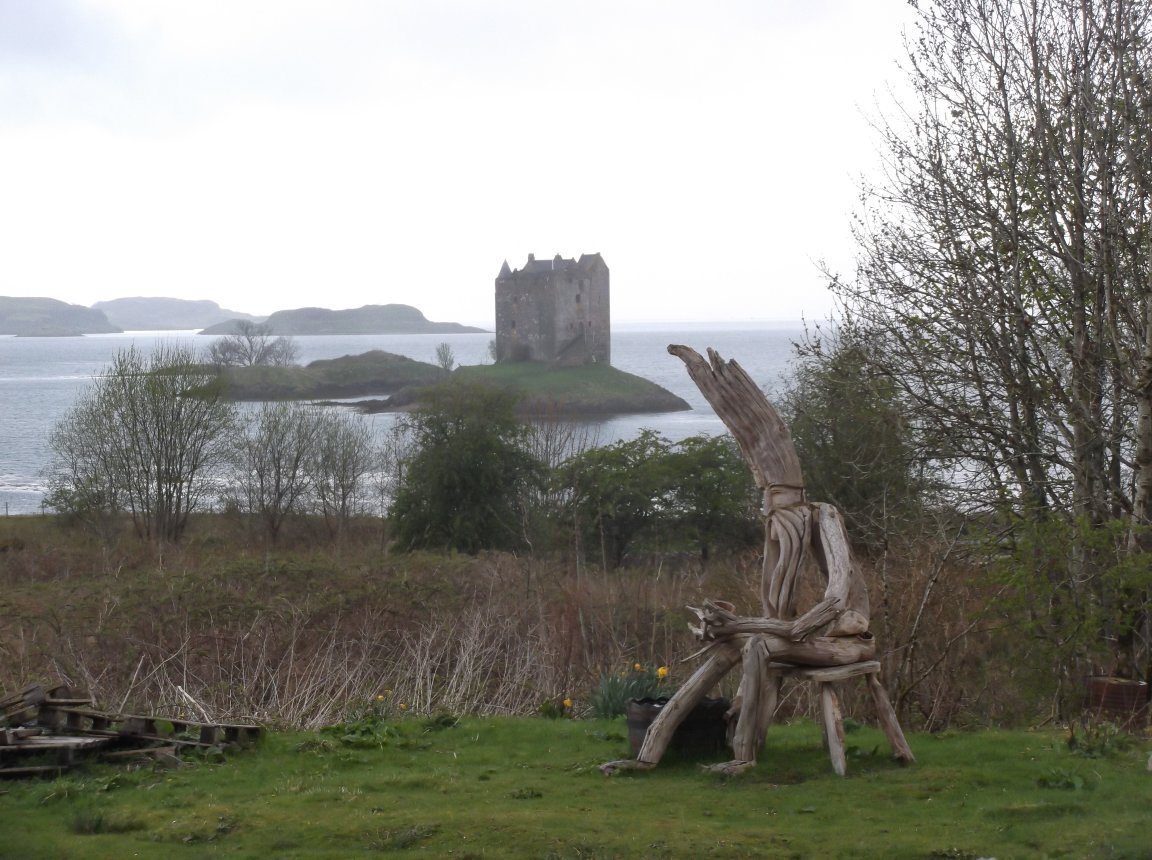Castle Stalker

Castle Stalker was built as a 4 storey towerhouse, set on a tidal islet
called Cormant's Rock within Loch Laich, itself an inlet of Loch
Linnhe. The name Stalker is said to come from the Gaelic
Stalcaire, meaning either hunter or falconer. The castle
starred
in the film, Monty Python and the Holy Grail.
It is stated as fact on Wikipedia
that the original castle was a small fort
built around 1320 by the Clan MacDougall, lords of Lorn. As
noted under Dunstaffnage,
the MacDougalls were in exile at this
time. The real history of the castle probably begins around
1388
when the Stewarts acquired the lordship. Probably the castle
was
built at this time or slightly later. Certainly there was a
John
Stewart of Castle Stalker by 1463. In that year he thought to
legitimize his only son, an illegitimate child, by marrying the mother
after his own wife had died. As he was also captain of
Dunstaffnage he
sought to make his marriage vows at the chapel outside
the castle. However he was wounded outside the church by a
party
led by a MacDougall, Alan MacCoul, and although he survived long enough
to marry he died the same day. His son, Dougal, consequently
became the first chief of Appin. The Stewarts and MacLarens
had
their revenge on the MacDougalls at the battle of Stalc in 1468, where
MacCoul was killed by Dougal himself.
Around 1620 Castle Stalker passed into the hands of
the Campbells of Airds as the result of a drunken wager by the seventh
chief, Duncan. In 1689 the Stewarts of Appin briefly regained
Stalker when they sided with King James VII (1633-1701) against King
William III (1650-1702), but were defeated at the battle of
Dunkeld. The castle was besieged for several
months in 1690, until the Stewart garrison surrendered.
Castle
Stalker
under the Campbells housed a garrison of 59 Government troops against
the Jacobite Rising of 1745, while a regiment of 300 Stewarts of Appin,
fighting for Prince Charles (1720-88), besieged the castle, but their
2lb cannon balls merely bounced off the walls. Following the
battle of Culloden in 1746, Stalker was used as a weapon surrender
centre and briefly as a prison. The last Campbell left
Stalker in
1800 and from then till 1840 the castle was just a storehouse, until
the roof either fell in or was removed to avoid taxes. In
1965
Lt. Col. D.R. Stewart Allward acquired the castle and over the next ten
years restored it.
Description
Other than the tower there are few traces of fortification on the
island although there is a rampart with elongated entrance to the
west. Access to the island has always been by small boat and
from
the landing place, a much damaged, roughly constructed staircase
ascended to the ward or barmkin. This, except on the north-west side,
seems to have enclosed the tower. Traces of a postern doorway
adjacent to the west corner
of the tower are still visible. Little
of the curtain wall remains, but a 10' long section of foundations
survive immediately south-west of the doorway. There are also some
scanty
remains at the north corner of the tower. This shows the wall
was
about 5' thick and 13' high. A rock-cut pool just below the
postern doorway appears to have constituted the only source of water
for the castle other than rainwater off the roof of the tower.
The towerhouse is rectangular, measuring 48' north-east to south-west
by 38' with walls 9' thick. It consists of a basement, two
upper
storeys and a garret. The ground floor entrance - possibly a
later insertion - is situated near the centre of the south-east wall and has
provision for two doors of which the inner, probably an iron yett, was
secured by a drawbar. This entrance is also protected by
machicolations at parapet level above. The ground floor
comprises 3 cellars and a prison pit, all of which are
barrel-vaulted.
In the north corner is a spiral stair, which rises to the full height
of
the building.
The principal entrance is in the north-east wall at first
floor level, probably originally reached by a timbered stairway, but
this arrangement was later replaced by a drawbridge which, in turn was
replaced by the current stone steps. The first and second
floors
each consist of a single large apartment, while above an enclosed
parapet walk surrounds the garret chamber.
Why not join me at Castle
Stalker and other
Great Scottish Castles this Spring?
Information on tours at Scholarly
Sojourns.
Copyright©2019
Paul Martin Remfry

